Development of Legal Independence of the Australian Legal System
VerifiedAdded on 2023/06/15
|18
|5709
|192
AI Summary
This article explores the timeline of the development of legal independence of the legislative and court system of Australia from 1787 to 1980s. It covers the establishment of the Constitution of Australia and the adversarial justice system.
Contribute Materials
Your contribution can guide someone’s learning journey. Share your
documents today.
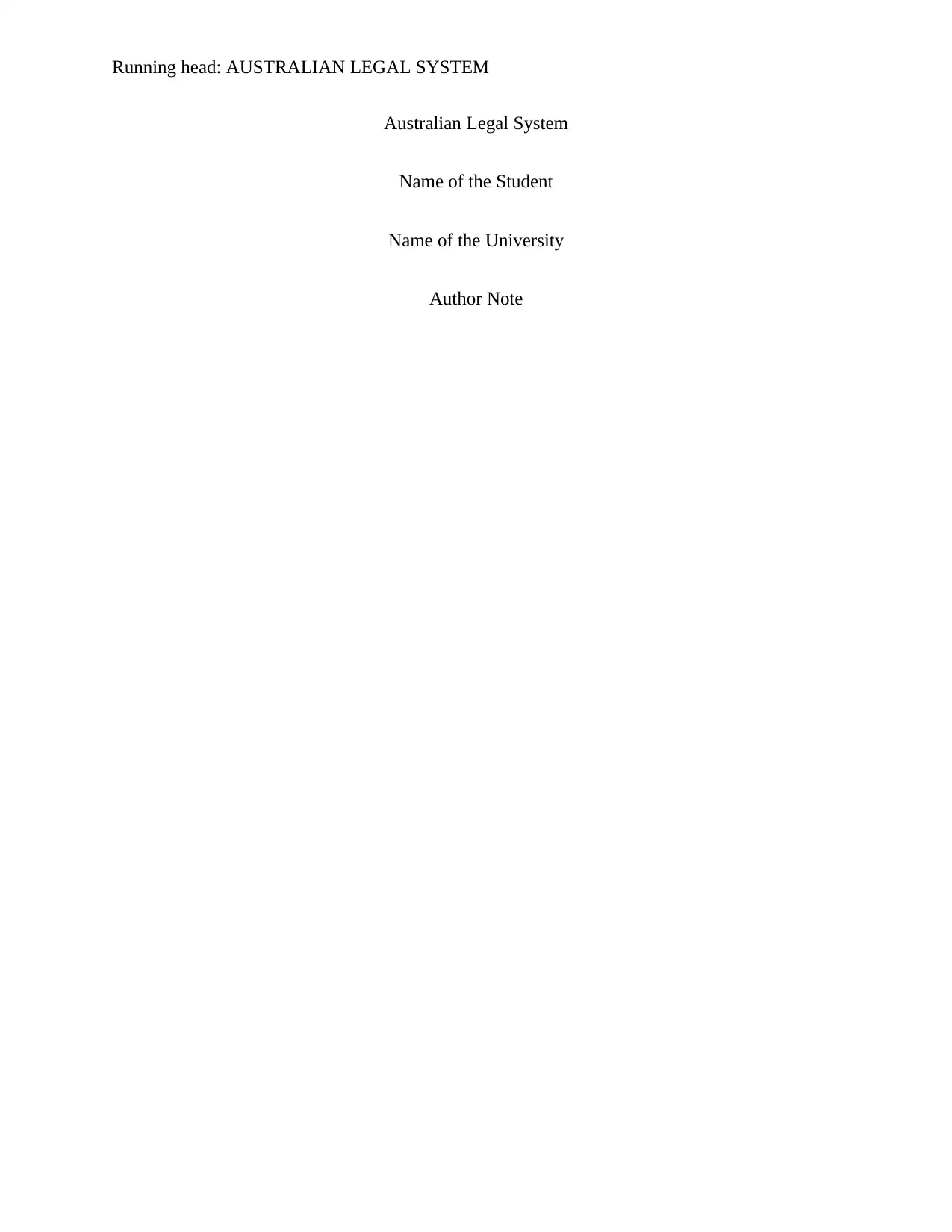
Running head: AUSTRALIAN LEGAL SYSTEM
Australian Legal System
Name of the Student
Name of the University
Author Note
Australian Legal System
Name of the Student
Name of the University
Author Note
Secure Best Marks with AI Grader
Need help grading? Try our AI Grader for instant feedback on your assignments.
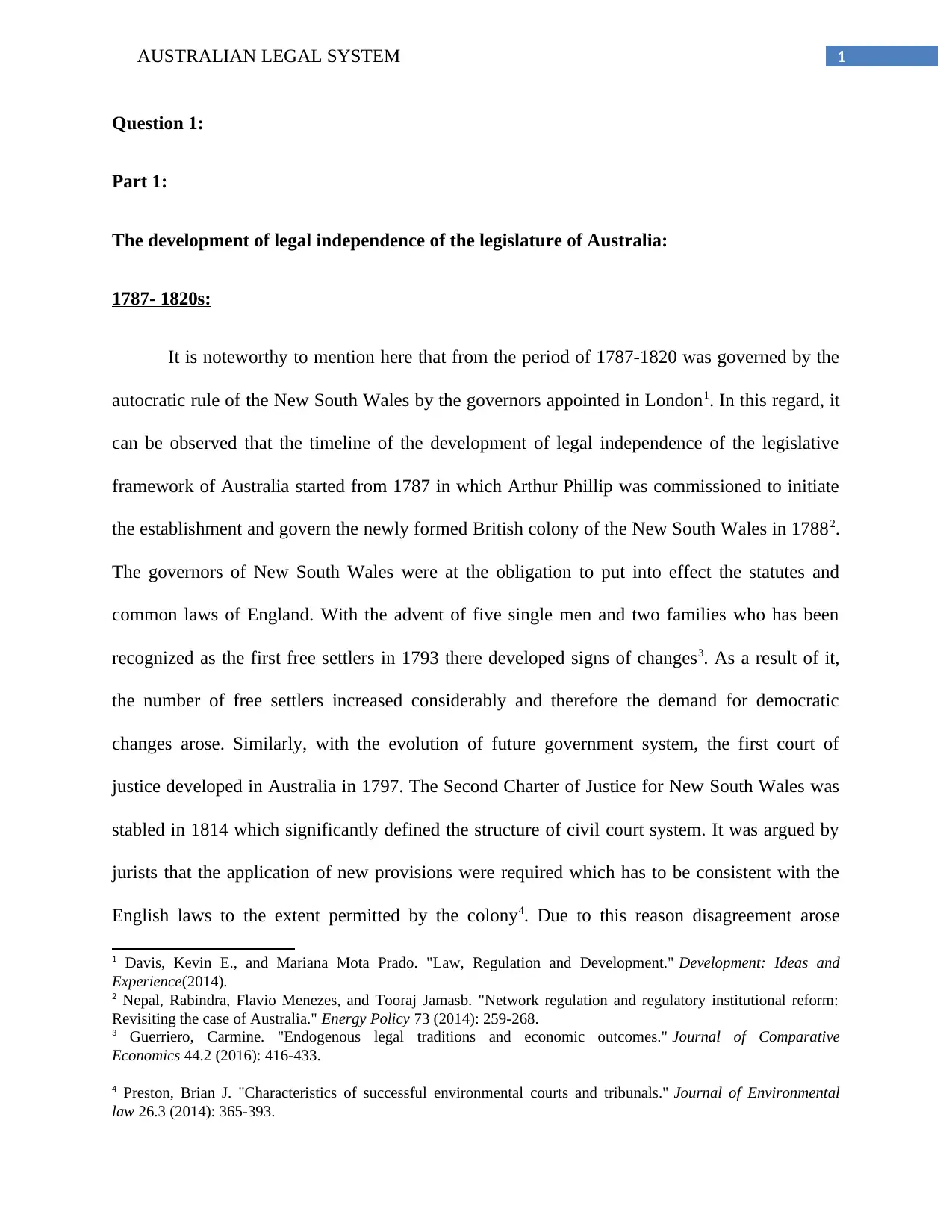
1AUSTRALIAN LEGAL SYSTEM
Question 1:
Part 1:
The development of legal independence of the legislature of Australia:
1787- 1820s:
It is noteworthy to mention here that from the period of 1787-1820 was governed by the
autocratic rule of the New South Wales by the governors appointed in London1. In this regard, it
can be observed that the timeline of the development of legal independence of the legislative
framework of Australia started from 1787 in which Arthur Phillip was commissioned to initiate
the establishment and govern the newly formed British colony of the New South Wales in 17882.
The governors of New South Wales were at the obligation to put into effect the statutes and
common laws of England. With the advent of five single men and two families who has been
recognized as the first free settlers in 1793 there developed signs of changes3. As a result of it,
the number of free settlers increased considerably and therefore the demand for democratic
changes arose. Similarly, with the evolution of future government system, the first court of
justice developed in Australia in 1797. The Second Charter of Justice for New South Wales was
stabled in 1814 which significantly defined the structure of civil court system. It was argued by
jurists that the application of new provisions were required which has to be consistent with the
English laws to the extent permitted by the colony4. Due to this reason disagreement arose
1 Davis, Kevin E., and Mariana Mota Prado. "Law, Regulation and Development." Development: Ideas and
Experience(2014).
2 Nepal, Rabindra, Flavio Menezes, and Tooraj Jamasb. "Network regulation and regulatory institutional reform:
Revisiting the case of Australia." Energy Policy 73 (2014): 259-268.
3 Guerriero, Carmine. "Endogenous legal traditions and economic outcomes." Journal of Comparative
Economics 44.2 (2016): 416-433.
4 Preston, Brian J. "Characteristics of successful environmental courts and tribunals." Journal of Environmental
law 26.3 (2014): 365-393.
Question 1:
Part 1:
The development of legal independence of the legislature of Australia:
1787- 1820s:
It is noteworthy to mention here that from the period of 1787-1820 was governed by the
autocratic rule of the New South Wales by the governors appointed in London1. In this regard, it
can be observed that the timeline of the development of legal independence of the legislative
framework of Australia started from 1787 in which Arthur Phillip was commissioned to initiate
the establishment and govern the newly formed British colony of the New South Wales in 17882.
The governors of New South Wales were at the obligation to put into effect the statutes and
common laws of England. With the advent of five single men and two families who has been
recognized as the first free settlers in 1793 there developed signs of changes3. As a result of it,
the number of free settlers increased considerably and therefore the demand for democratic
changes arose. Similarly, with the evolution of future government system, the first court of
justice developed in Australia in 1797. The Second Charter of Justice for New South Wales was
stabled in 1814 which significantly defined the structure of civil court system. It was argued by
jurists that the application of new provisions were required which has to be consistent with the
English laws to the extent permitted by the colony4. Due to this reason disagreement arose
1 Davis, Kevin E., and Mariana Mota Prado. "Law, Regulation and Development." Development: Ideas and
Experience(2014).
2 Nepal, Rabindra, Flavio Menezes, and Tooraj Jamasb. "Network regulation and regulatory institutional reform:
Revisiting the case of Australia." Energy Policy 73 (2014): 259-268.
3 Guerriero, Carmine. "Endogenous legal traditions and economic outcomes." Journal of Comparative
Economics 44.2 (2016): 416-433.
4 Preston, Brian J. "Characteristics of successful environmental courts and tribunals." Journal of Environmental
law 26.3 (2014): 365-393.
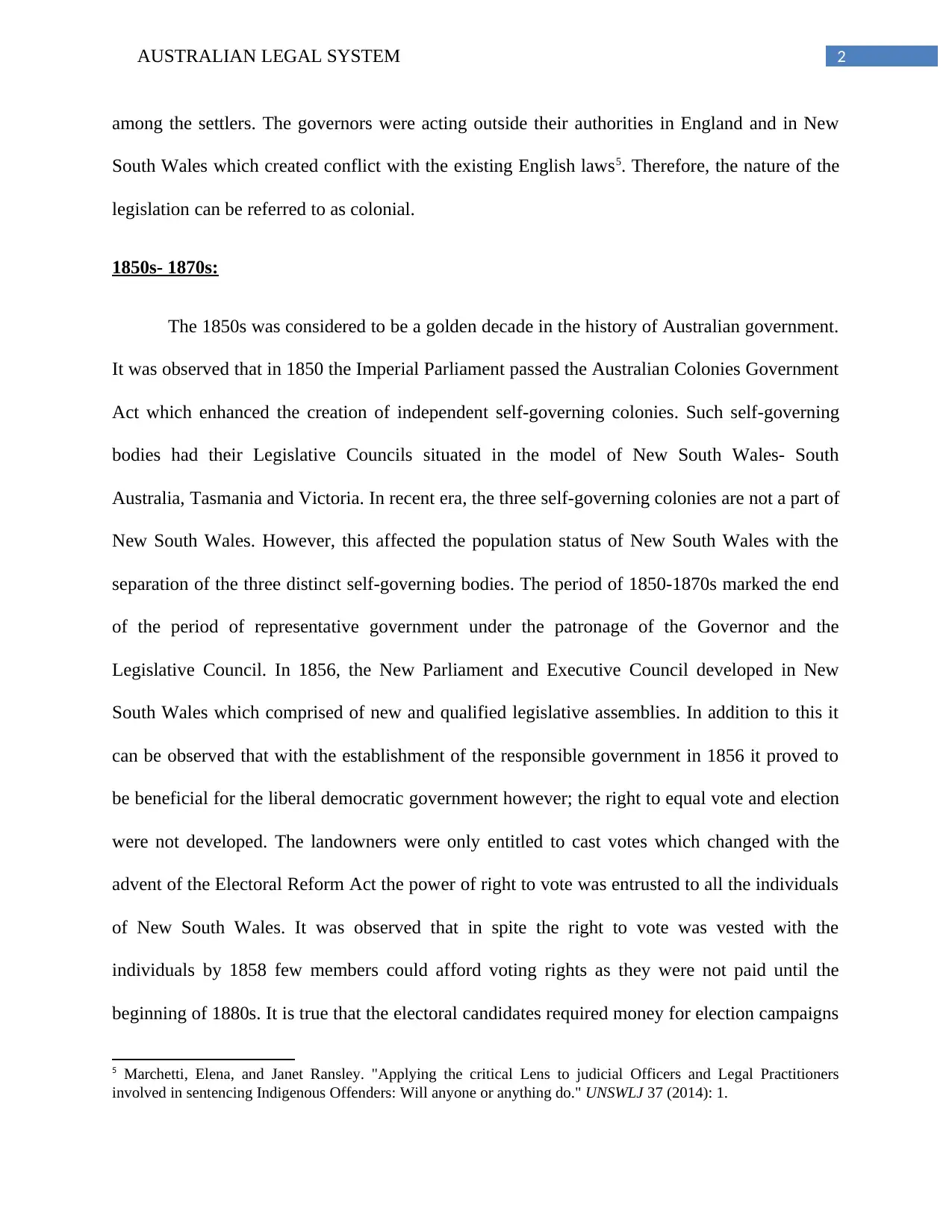
2AUSTRALIAN LEGAL SYSTEM
among the settlers. The governors were acting outside their authorities in England and in New
South Wales which created conflict with the existing English laws5. Therefore, the nature of the
legislation can be referred to as colonial.
1850s- 1870s:
The 1850s was considered to be a golden decade in the history of Australian government.
It was observed that in 1850 the Imperial Parliament passed the Australian Colonies Government
Act which enhanced the creation of independent self-governing colonies. Such self-governing
bodies had their Legislative Councils situated in the model of New South Wales- South
Australia, Tasmania and Victoria. In recent era, the three self-governing colonies are not a part of
New South Wales. However, this affected the population status of New South Wales with the
separation of the three distinct self-governing bodies. The period of 1850-1870s marked the end
of the period of representative government under the patronage of the Governor and the
Legislative Council. In 1856, the New Parliament and Executive Council developed in New
South Wales which comprised of new and qualified legislative assemblies. In addition to this it
can be observed that with the establishment of the responsible government in 1856 it proved to
be beneficial for the liberal democratic government however; the right to equal vote and election
were not developed. The landowners were only entitled to cast votes which changed with the
advent of the Electoral Reform Act the power of right to vote was entrusted to all the individuals
of New South Wales. It was observed that in spite the right to vote was vested with the
individuals by 1858 few members could afford voting rights as they were not paid until the
beginning of 1880s. It is true that the electoral candidates required money for election campaigns
5 Marchetti, Elena, and Janet Ransley. "Applying the critical Lens to judicial Officers and Legal Practitioners
involved in sentencing Indigenous Offenders: Will anyone or anything do." UNSWLJ 37 (2014): 1.
among the settlers. The governors were acting outside their authorities in England and in New
South Wales which created conflict with the existing English laws5. Therefore, the nature of the
legislation can be referred to as colonial.
1850s- 1870s:
The 1850s was considered to be a golden decade in the history of Australian government.
It was observed that in 1850 the Imperial Parliament passed the Australian Colonies Government
Act which enhanced the creation of independent self-governing colonies. Such self-governing
bodies had their Legislative Councils situated in the model of New South Wales- South
Australia, Tasmania and Victoria. In recent era, the three self-governing colonies are not a part of
New South Wales. However, this affected the population status of New South Wales with the
separation of the three distinct self-governing bodies. The period of 1850-1870s marked the end
of the period of representative government under the patronage of the Governor and the
Legislative Council. In 1856, the New Parliament and Executive Council developed in New
South Wales which comprised of new and qualified legislative assemblies. In addition to this it
can be observed that with the establishment of the responsible government in 1856 it proved to
be beneficial for the liberal democratic government however; the right to equal vote and election
were not developed. The landowners were only entitled to cast votes which changed with the
advent of the Electoral Reform Act the power of right to vote was entrusted to all the individuals
of New South Wales. It was observed that in spite the right to vote was vested with the
individuals by 1858 few members could afford voting rights as they were not paid until the
beginning of 1880s. It is true that the electoral candidates required money for election campaigns
5 Marchetti, Elena, and Janet Ransley. "Applying the critical Lens to judicial Officers and Legal Practitioners
involved in sentencing Indigenous Offenders: Will anyone or anything do." UNSWLJ 37 (2014): 1.
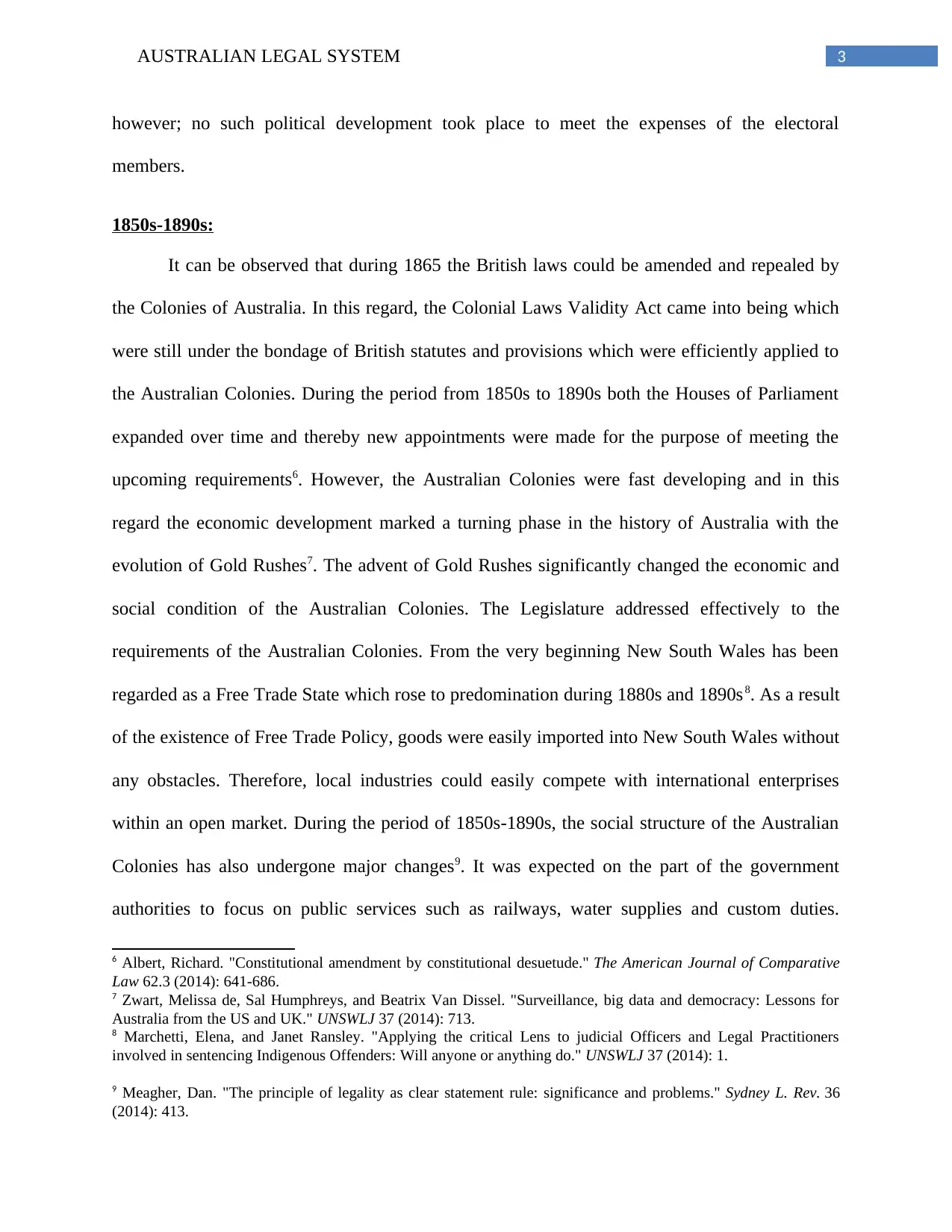
3AUSTRALIAN LEGAL SYSTEM
however; no such political development took place to meet the expenses of the electoral
members.
1850s-1890s:
It can be observed that during 1865 the British laws could be amended and repealed by
the Colonies of Australia. In this regard, the Colonial Laws Validity Act came into being which
were still under the bondage of British statutes and provisions which were efficiently applied to
the Australian Colonies. During the period from 1850s to 1890s both the Houses of Parliament
expanded over time and thereby new appointments were made for the purpose of meeting the
upcoming requirements6. However, the Australian Colonies were fast developing and in this
regard the economic development marked a turning phase in the history of Australia with the
evolution of Gold Rushes7. The advent of Gold Rushes significantly changed the economic and
social condition of the Australian Colonies. The Legislature addressed effectively to the
requirements of the Australian Colonies. From the very beginning New South Wales has been
regarded as a Free Trade State which rose to predomination during 1880s and 1890s8. As a result
of the existence of Free Trade Policy, goods were easily imported into New South Wales without
any obstacles. Therefore, local industries could easily compete with international enterprises
within an open market. During the period of 1850s-1890s, the social structure of the Australian
Colonies has also undergone major changes9. It was expected on the part of the government
authorities to focus on public services such as railways, water supplies and custom duties.
6 Albert, Richard. "Constitutional amendment by constitutional desuetude." The American Journal of Comparative
Law 62.3 (2014): 641-686.
7 Zwart, Melissa de, Sal Humphreys, and Beatrix Van Dissel. "Surveillance, big data and democracy: Lessons for
Australia from the US and UK." UNSWLJ 37 (2014): 713.
8 Marchetti, Elena, and Janet Ransley. "Applying the critical Lens to judicial Officers and Legal Practitioners
involved in sentencing Indigenous Offenders: Will anyone or anything do." UNSWLJ 37 (2014): 1.
9 Meagher, Dan. "The principle of legality as clear statement rule: significance and problems." Sydney L. Rev. 36
(2014): 413.
however; no such political development took place to meet the expenses of the electoral
members.
1850s-1890s:
It can be observed that during 1865 the British laws could be amended and repealed by
the Colonies of Australia. In this regard, the Colonial Laws Validity Act came into being which
were still under the bondage of British statutes and provisions which were efficiently applied to
the Australian Colonies. During the period from 1850s to 1890s both the Houses of Parliament
expanded over time and thereby new appointments were made for the purpose of meeting the
upcoming requirements6. However, the Australian Colonies were fast developing and in this
regard the economic development marked a turning phase in the history of Australia with the
evolution of Gold Rushes7. The advent of Gold Rushes significantly changed the economic and
social condition of the Australian Colonies. The Legislature addressed effectively to the
requirements of the Australian Colonies. From the very beginning New South Wales has been
regarded as a Free Trade State which rose to predomination during 1880s and 1890s8. As a result
of the existence of Free Trade Policy, goods were easily imported into New South Wales without
any obstacles. Therefore, local industries could easily compete with international enterprises
within an open market. During the period of 1850s-1890s, the social structure of the Australian
Colonies has also undergone major changes9. It was expected on the part of the government
authorities to focus on public services such as railways, water supplies and custom duties.
6 Albert, Richard. "Constitutional amendment by constitutional desuetude." The American Journal of Comparative
Law 62.3 (2014): 641-686.
7 Zwart, Melissa de, Sal Humphreys, and Beatrix Van Dissel. "Surveillance, big data and democracy: Lessons for
Australia from the US and UK." UNSWLJ 37 (2014): 713.
8 Marchetti, Elena, and Janet Ransley. "Applying the critical Lens to judicial Officers and Legal Practitioners
involved in sentencing Indigenous Offenders: Will anyone or anything do." UNSWLJ 37 (2014): 1.
9 Meagher, Dan. "The principle of legality as clear statement rule: significance and problems." Sydney L. Rev. 36
(2014): 413.
Secure Best Marks with AI Grader
Need help grading? Try our AI Grader for instant feedback on your assignments.
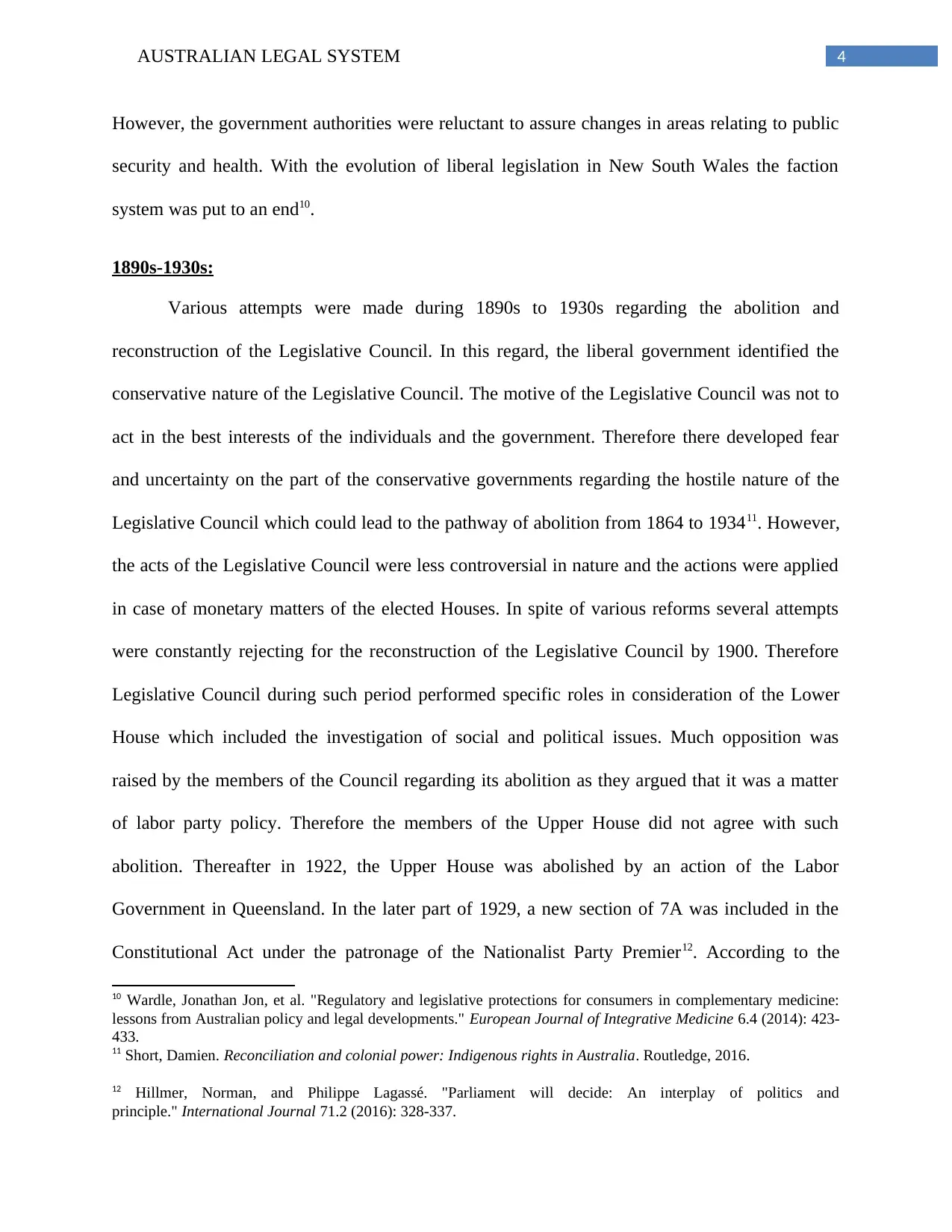
4AUSTRALIAN LEGAL SYSTEM
However, the government authorities were reluctant to assure changes in areas relating to public
security and health. With the evolution of liberal legislation in New South Wales the faction
system was put to an end10.
1890s-1930s:
Various attempts were made during 1890s to 1930s regarding the abolition and
reconstruction of the Legislative Council. In this regard, the liberal government identified the
conservative nature of the Legislative Council. The motive of the Legislative Council was not to
act in the best interests of the individuals and the government. Therefore there developed fear
and uncertainty on the part of the conservative governments regarding the hostile nature of the
Legislative Council which could lead to the pathway of abolition from 1864 to 193411. However,
the acts of the Legislative Council were less controversial in nature and the actions were applied
in case of monetary matters of the elected Houses. In spite of various reforms several attempts
were constantly rejecting for the reconstruction of the Legislative Council by 1900. Therefore
Legislative Council during such period performed specific roles in consideration of the Lower
House which included the investigation of social and political issues. Much opposition was
raised by the members of the Council regarding its abolition as they argued that it was a matter
of labor party policy. Therefore the members of the Upper House did not agree with such
abolition. Thereafter in 1922, the Upper House was abolished by an action of the Labor
Government in Queensland. In the later part of 1929, a new section of 7A was included in the
Constitutional Act under the patronage of the Nationalist Party Premier12. According to the
10 Wardle, Jonathan Jon, et al. "Regulatory and legislative protections for consumers in complementary medicine:
lessons from Australian policy and legal developments." European Journal of Integrative Medicine 6.4 (2014): 423-
433.
11 Short, Damien. Reconciliation and colonial power: Indigenous rights in Australia. Routledge, 2016.
12 Hillmer, Norman, and Philippe Lagassé. "Parliament will decide: An interplay of politics and
principle." International Journal 71.2 (2016): 328-337.
However, the government authorities were reluctant to assure changes in areas relating to public
security and health. With the evolution of liberal legislation in New South Wales the faction
system was put to an end10.
1890s-1930s:
Various attempts were made during 1890s to 1930s regarding the abolition and
reconstruction of the Legislative Council. In this regard, the liberal government identified the
conservative nature of the Legislative Council. The motive of the Legislative Council was not to
act in the best interests of the individuals and the government. Therefore there developed fear
and uncertainty on the part of the conservative governments regarding the hostile nature of the
Legislative Council which could lead to the pathway of abolition from 1864 to 193411. However,
the acts of the Legislative Council were less controversial in nature and the actions were applied
in case of monetary matters of the elected Houses. In spite of various reforms several attempts
were constantly rejecting for the reconstruction of the Legislative Council by 1900. Therefore
Legislative Council during such period performed specific roles in consideration of the Lower
House which included the investigation of social and political issues. Much opposition was
raised by the members of the Council regarding its abolition as they argued that it was a matter
of labor party policy. Therefore the members of the Upper House did not agree with such
abolition. Thereafter in 1922, the Upper House was abolished by an action of the Labor
Government in Queensland. In the later part of 1929, a new section of 7A was included in the
Constitutional Act under the patronage of the Nationalist Party Premier12. According to the
10 Wardle, Jonathan Jon, et al. "Regulatory and legislative protections for consumers in complementary medicine:
lessons from Australian policy and legal developments." European Journal of Integrative Medicine 6.4 (2014): 423-
433.
11 Short, Damien. Reconciliation and colonial power: Indigenous rights in Australia. Routledge, 2016.
12 Hillmer, Norman, and Philippe Lagassé. "Parliament will decide: An interplay of politics and
principle." International Journal 71.2 (2016): 328-337.
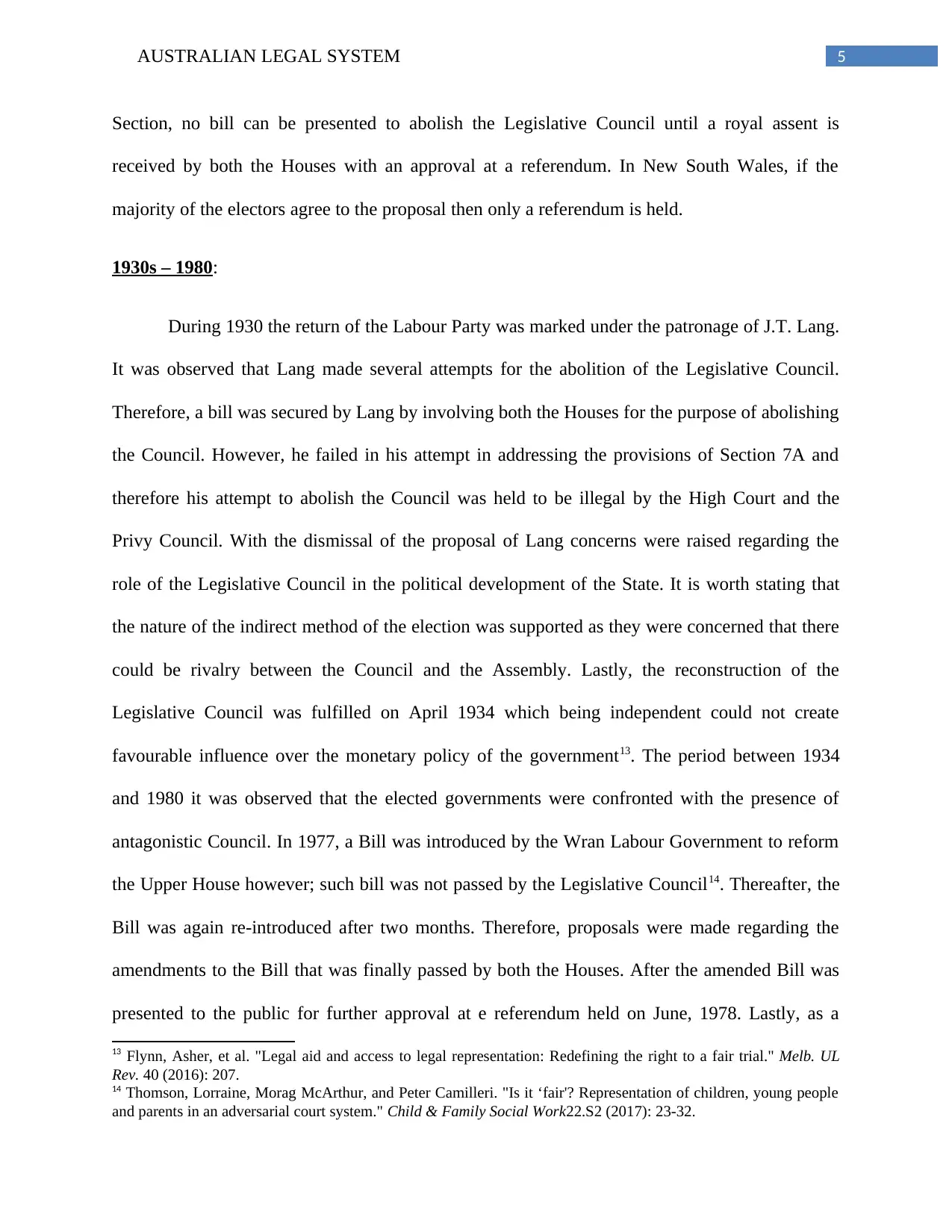
5AUSTRALIAN LEGAL SYSTEM
Section, no bill can be presented to abolish the Legislative Council until a royal assent is
received by both the Houses with an approval at a referendum. In New South Wales, if the
majority of the electors agree to the proposal then only a referendum is held.
1930s – 1980:
During 1930 the return of the Labour Party was marked under the patronage of J.T. Lang.
It was observed that Lang made several attempts for the abolition of the Legislative Council.
Therefore, a bill was secured by Lang by involving both the Houses for the purpose of abolishing
the Council. However, he failed in his attempt in addressing the provisions of Section 7A and
therefore his attempt to abolish the Council was held to be illegal by the High Court and the
Privy Council. With the dismissal of the proposal of Lang concerns were raised regarding the
role of the Legislative Council in the political development of the State. It is worth stating that
the nature of the indirect method of the election was supported as they were concerned that there
could be rivalry between the Council and the Assembly. Lastly, the reconstruction of the
Legislative Council was fulfilled on April 1934 which being independent could not create
favourable influence over the monetary policy of the government13. The period between 1934
and 1980 it was observed that the elected governments were confronted with the presence of
antagonistic Council. In 1977, a Bill was introduced by the Wran Labour Government to reform
the Upper House however; such bill was not passed by the Legislative Council14. Thereafter, the
Bill was again re-introduced after two months. Therefore, proposals were made regarding the
amendments to the Bill that was finally passed by both the Houses. After the amended Bill was
presented to the public for further approval at e referendum held on June, 1978. Lastly, as a
13 Flynn, Asher, et al. "Legal aid and access to legal representation: Redefining the right to a fair trial." Melb. UL
Rev. 40 (2016): 207.
14 Thomson, Lorraine, Morag McArthur, and Peter Camilleri. "Is it ‘fair'? Representation of children, young people
and parents in an adversarial court system." Child & Family Social Work22.S2 (2017): 23-32.
Section, no bill can be presented to abolish the Legislative Council until a royal assent is
received by both the Houses with an approval at a referendum. In New South Wales, if the
majority of the electors agree to the proposal then only a referendum is held.
1930s – 1980:
During 1930 the return of the Labour Party was marked under the patronage of J.T. Lang.
It was observed that Lang made several attempts for the abolition of the Legislative Council.
Therefore, a bill was secured by Lang by involving both the Houses for the purpose of abolishing
the Council. However, he failed in his attempt in addressing the provisions of Section 7A and
therefore his attempt to abolish the Council was held to be illegal by the High Court and the
Privy Council. With the dismissal of the proposal of Lang concerns were raised regarding the
role of the Legislative Council in the political development of the State. It is worth stating that
the nature of the indirect method of the election was supported as they were concerned that there
could be rivalry between the Council and the Assembly. Lastly, the reconstruction of the
Legislative Council was fulfilled on April 1934 which being independent could not create
favourable influence over the monetary policy of the government13. The period between 1934
and 1980 it was observed that the elected governments were confronted with the presence of
antagonistic Council. In 1977, a Bill was introduced by the Wran Labour Government to reform
the Upper House however; such bill was not passed by the Legislative Council14. Thereafter, the
Bill was again re-introduced after two months. Therefore, proposals were made regarding the
amendments to the Bill that was finally passed by both the Houses. After the amended Bill was
presented to the public for further approval at e referendum held on June, 1978. Lastly, as a
13 Flynn, Asher, et al. "Legal aid and access to legal representation: Redefining the right to a fair trial." Melb. UL
Rev. 40 (2016): 207.
14 Thomson, Lorraine, Morag McArthur, and Peter Camilleri. "Is it ‘fair'? Representation of children, young people
and parents in an adversarial court system." Child & Family Social Work22.S2 (2017): 23-32.

6AUSTRALIAN LEGAL SYSTEM
result of the act of the Greiner Liberal-National Party Government at a referendum held in 1991
there was a reduction in the number of the members of both the Houses.
Part 2:
The development of legal independence of the Court system in Australia:
1787s -1820s:
During this period, the governor, lieutenant governor and the judge was authorized by the
First Charter of Justice with the power to proceed with the establishment of a criminal court. The
governor was entrusted with the power of appointing and dismissing magistrates. In this regard,
civil and military officers were appointed who possessed similar powers to those of the
magistrates. Such civil and military officers were at the authority to imprison individuals
regarding minor criminal cases. However, the First Charter of Justice also established the court
of civil jurisdiction for the purpose of hearing and deciding cases related to property and
contracts15. During this period D’Arcy was declared at the first paid magistrate. Prior to this, the
powers and duties of the magistrates were confined to other positions. In 1821, court houses
were established exceeding an amount of 300 in New South Wales.
1820s-1850s:
After 1830, the payment of the magistrates was commonly practiced. However from the
period of 1820 and 1850, the legal system of Australia developed. Previously, it was governed by
the principles of common law of England. It was observed that the legal structure of Australia
was formulated on the basis of the British legal system as a result of the emergence of the
15 Gordon, Michael. "The UK's Sovereignty Situation: Brexit, Bewilderment and Beyond…." King's Law
Journal 27.3 (2016): 333-343.
result of the act of the Greiner Liberal-National Party Government at a referendum held in 1991
there was a reduction in the number of the members of both the Houses.
Part 2:
The development of legal independence of the Court system in Australia:
1787s -1820s:
During this period, the governor, lieutenant governor and the judge was authorized by the
First Charter of Justice with the power to proceed with the establishment of a criminal court. The
governor was entrusted with the power of appointing and dismissing magistrates. In this regard,
civil and military officers were appointed who possessed similar powers to those of the
magistrates. Such civil and military officers were at the authority to imprison individuals
regarding minor criminal cases. However, the First Charter of Justice also established the court
of civil jurisdiction for the purpose of hearing and deciding cases related to property and
contracts15. During this period D’Arcy was declared at the first paid magistrate. Prior to this, the
powers and duties of the magistrates were confined to other positions. In 1821, court houses
were established exceeding an amount of 300 in New South Wales.
1820s-1850s:
After 1830, the payment of the magistrates was commonly practiced. However from the
period of 1820 and 1850, the legal system of Australia developed. Previously, it was governed by
the principles of common law of England. It was observed that the legal structure of Australia
was formulated on the basis of the British legal system as a result of the emergence of the
15 Gordon, Michael. "The UK's Sovereignty Situation: Brexit, Bewilderment and Beyond…." King's Law
Journal 27.3 (2016): 333-343.
Paraphrase This Document
Need a fresh take? Get an instant paraphrase of this document with our AI Paraphraser
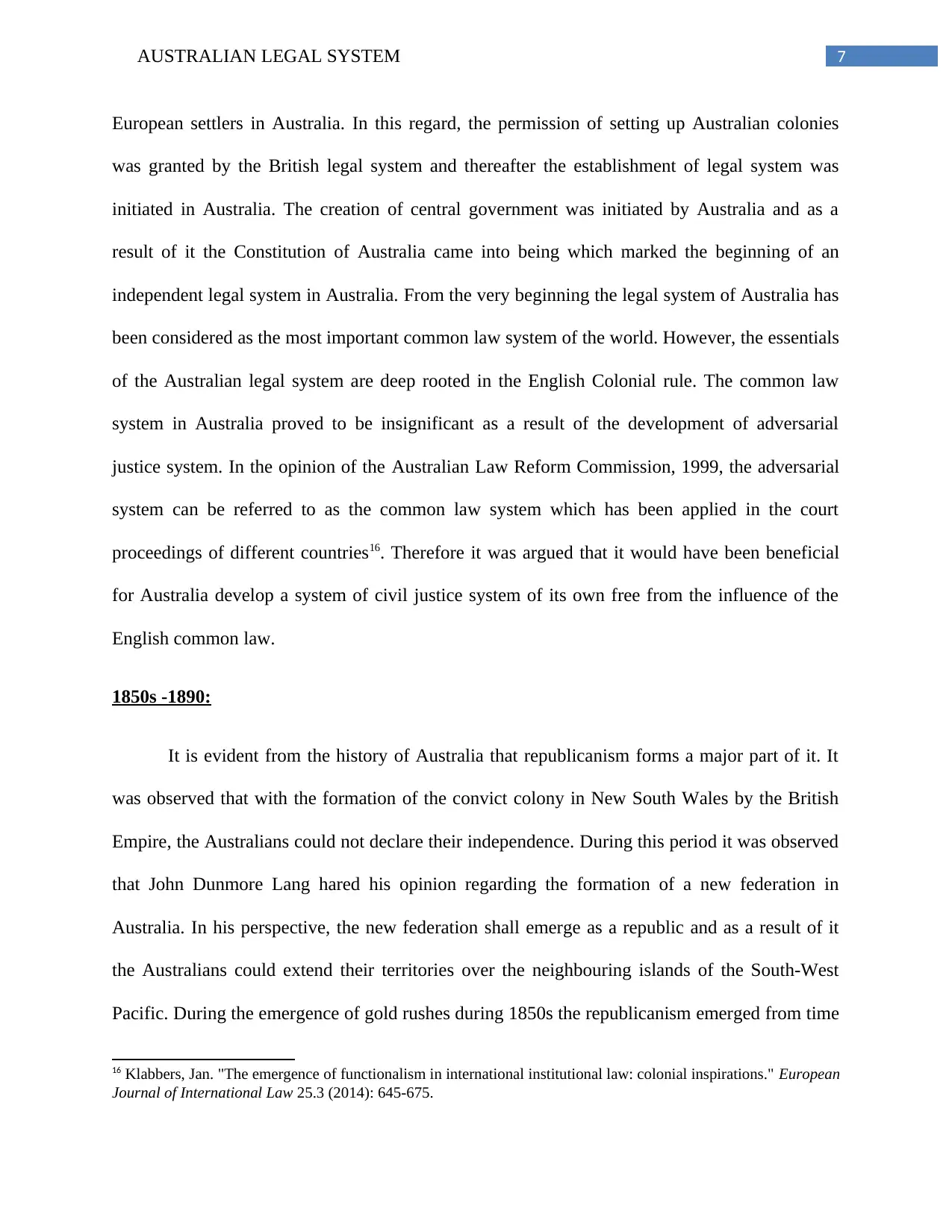
7AUSTRALIAN LEGAL SYSTEM
European settlers in Australia. In this regard, the permission of setting up Australian colonies
was granted by the British legal system and thereafter the establishment of legal system was
initiated in Australia. The creation of central government was initiated by Australia and as a
result of it the Constitution of Australia came into being which marked the beginning of an
independent legal system in Australia. From the very beginning the legal system of Australia has
been considered as the most important common law system of the world. However, the essentials
of the Australian legal system are deep rooted in the English Colonial rule. The common law
system in Australia proved to be insignificant as a result of the development of adversarial
justice system. In the opinion of the Australian Law Reform Commission, 1999, the adversarial
system can be referred to as the common law system which has been applied in the court
proceedings of different countries16. Therefore it was argued that it would have been beneficial
for Australia develop a system of civil justice system of its own free from the influence of the
English common law.
1850s -1890:
It is evident from the history of Australia that republicanism forms a major part of it. It
was observed that with the formation of the convict colony in New South Wales by the British
Empire, the Australians could not declare their independence. During this period it was observed
that John Dunmore Lang hared his opinion regarding the formation of a new federation in
Australia. In his perspective, the new federation shall emerge as a republic and as a result of it
the Australians could extend their territories over the neighbouring islands of the South-West
Pacific. During the emergence of gold rushes during 1850s the republicanism emerged from time
16 Klabbers, Jan. "The emergence of functionalism in international institutional law: colonial inspirations." European
Journal of International Law 25.3 (2014): 645-675.
European settlers in Australia. In this regard, the permission of setting up Australian colonies
was granted by the British legal system and thereafter the establishment of legal system was
initiated in Australia. The creation of central government was initiated by Australia and as a
result of it the Constitution of Australia came into being which marked the beginning of an
independent legal system in Australia. From the very beginning the legal system of Australia has
been considered as the most important common law system of the world. However, the essentials
of the Australian legal system are deep rooted in the English Colonial rule. The common law
system in Australia proved to be insignificant as a result of the development of adversarial
justice system. In the opinion of the Australian Law Reform Commission, 1999, the adversarial
system can be referred to as the common law system which has been applied in the court
proceedings of different countries16. Therefore it was argued that it would have been beneficial
for Australia develop a system of civil justice system of its own free from the influence of the
English common law.
1850s -1890:
It is evident from the history of Australia that republicanism forms a major part of it. It
was observed that with the formation of the convict colony in New South Wales by the British
Empire, the Australians could not declare their independence. During this period it was observed
that John Dunmore Lang hared his opinion regarding the formation of a new federation in
Australia. In his perspective, the new federation shall emerge as a republic and as a result of it
the Australians could extend their territories over the neighbouring islands of the South-West
Pacific. During the emergence of gold rushes during 1850s the republicanism emerged from time
16 Klabbers, Jan. "The emergence of functionalism in international institutional law: colonial inspirations." European
Journal of International Law 25.3 (2014): 645-675.
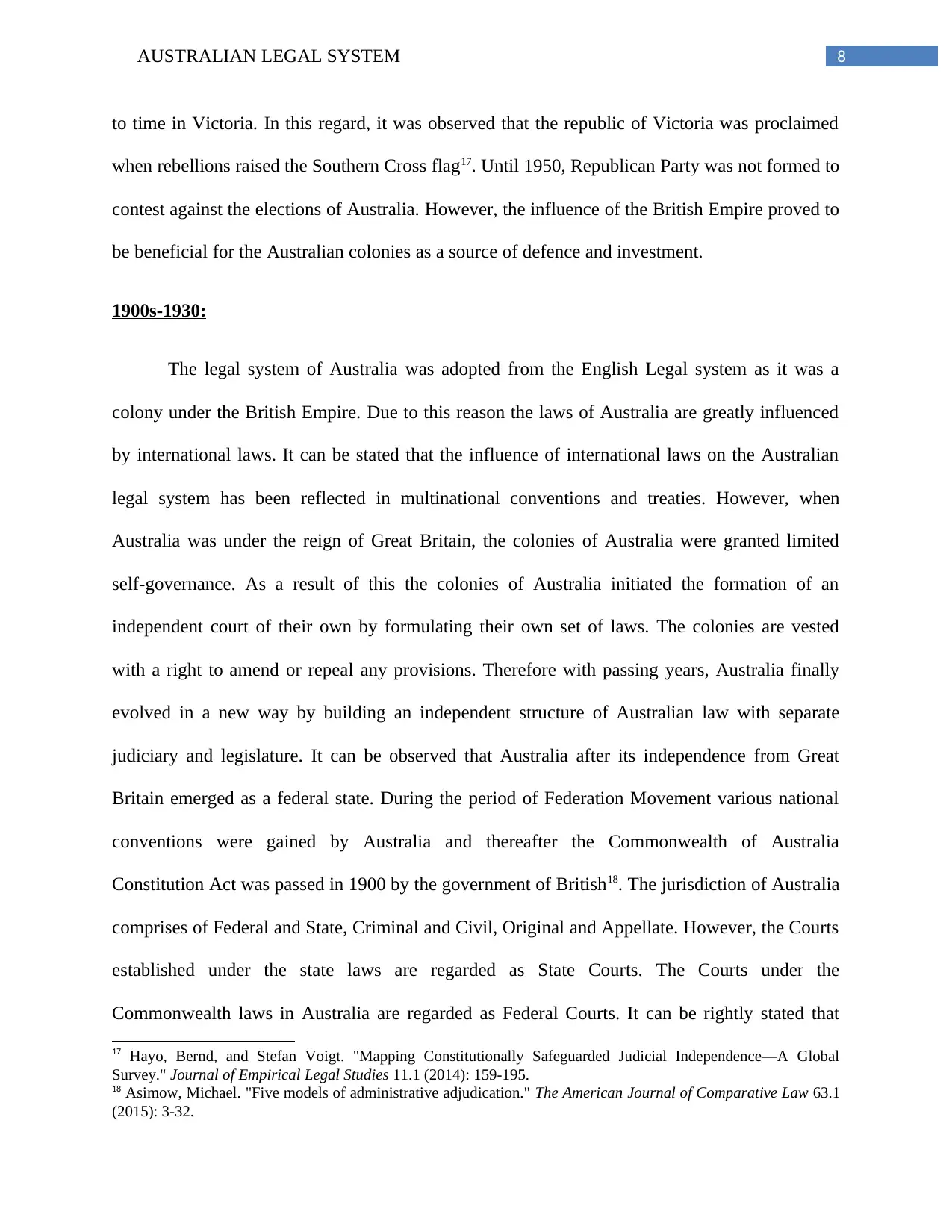
8AUSTRALIAN LEGAL SYSTEM
to time in Victoria. In this regard, it was observed that the republic of Victoria was proclaimed
when rebellions raised the Southern Cross flag17. Until 1950, Republican Party was not formed to
contest against the elections of Australia. However, the influence of the British Empire proved to
be beneficial for the Australian colonies as a source of defence and investment.
1900s-1930:
The legal system of Australia was adopted from the English Legal system as it was a
colony under the British Empire. Due to this reason the laws of Australia are greatly influenced
by international laws. It can be stated that the influence of international laws on the Australian
legal system has been reflected in multinational conventions and treaties. However, when
Australia was under the reign of Great Britain, the colonies of Australia were granted limited
self-governance. As a result of this the colonies of Australia initiated the formation of an
independent court of their own by formulating their own set of laws. The colonies are vested
with a right to amend or repeal any provisions. Therefore with passing years, Australia finally
evolved in a new way by building an independent structure of Australian law with separate
judiciary and legislature. It can be observed that Australia after its independence from Great
Britain emerged as a federal state. During the period of Federation Movement various national
conventions were gained by Australia and thereafter the Commonwealth of Australia
Constitution Act was passed in 1900 by the government of British18. The jurisdiction of Australia
comprises of Federal and State, Criminal and Civil, Original and Appellate. However, the Courts
established under the state laws are regarded as State Courts. The Courts under the
Commonwealth laws in Australia are regarded as Federal Courts. It can be rightly stated that
17 Hayo, Bernd, and Stefan Voigt. "Mapping Constitutionally Safeguarded Judicial Independence—A Global
Survey." Journal of Empirical Legal Studies 11.1 (2014): 159-195.
18 Asimow, Michael. "Five models of administrative adjudication." The American Journal of Comparative Law 63.1
(2015): 3-32.
to time in Victoria. In this regard, it was observed that the republic of Victoria was proclaimed
when rebellions raised the Southern Cross flag17. Until 1950, Republican Party was not formed to
contest against the elections of Australia. However, the influence of the British Empire proved to
be beneficial for the Australian colonies as a source of defence and investment.
1900s-1930:
The legal system of Australia was adopted from the English Legal system as it was a
colony under the British Empire. Due to this reason the laws of Australia are greatly influenced
by international laws. It can be stated that the influence of international laws on the Australian
legal system has been reflected in multinational conventions and treaties. However, when
Australia was under the reign of Great Britain, the colonies of Australia were granted limited
self-governance. As a result of this the colonies of Australia initiated the formation of an
independent court of their own by formulating their own set of laws. The colonies are vested
with a right to amend or repeal any provisions. Therefore with passing years, Australia finally
evolved in a new way by building an independent structure of Australian law with separate
judiciary and legislature. It can be observed that Australia after its independence from Great
Britain emerged as a federal state. During the period of Federation Movement various national
conventions were gained by Australia and thereafter the Commonwealth of Australia
Constitution Act was passed in 1900 by the government of British18. The jurisdiction of Australia
comprises of Federal and State, Criminal and Civil, Original and Appellate. However, the Courts
established under the state laws are regarded as State Courts. The Courts under the
Commonwealth laws in Australia are regarded as Federal Courts. It can be rightly stated that
17 Hayo, Bernd, and Stefan Voigt. "Mapping Constitutionally Safeguarded Judicial Independence—A Global
Survey." Journal of Empirical Legal Studies 11.1 (2014): 159-195.
18 Asimow, Michael. "Five models of administrative adjudication." The American Journal of Comparative Law 63.1
(2015): 3-32.
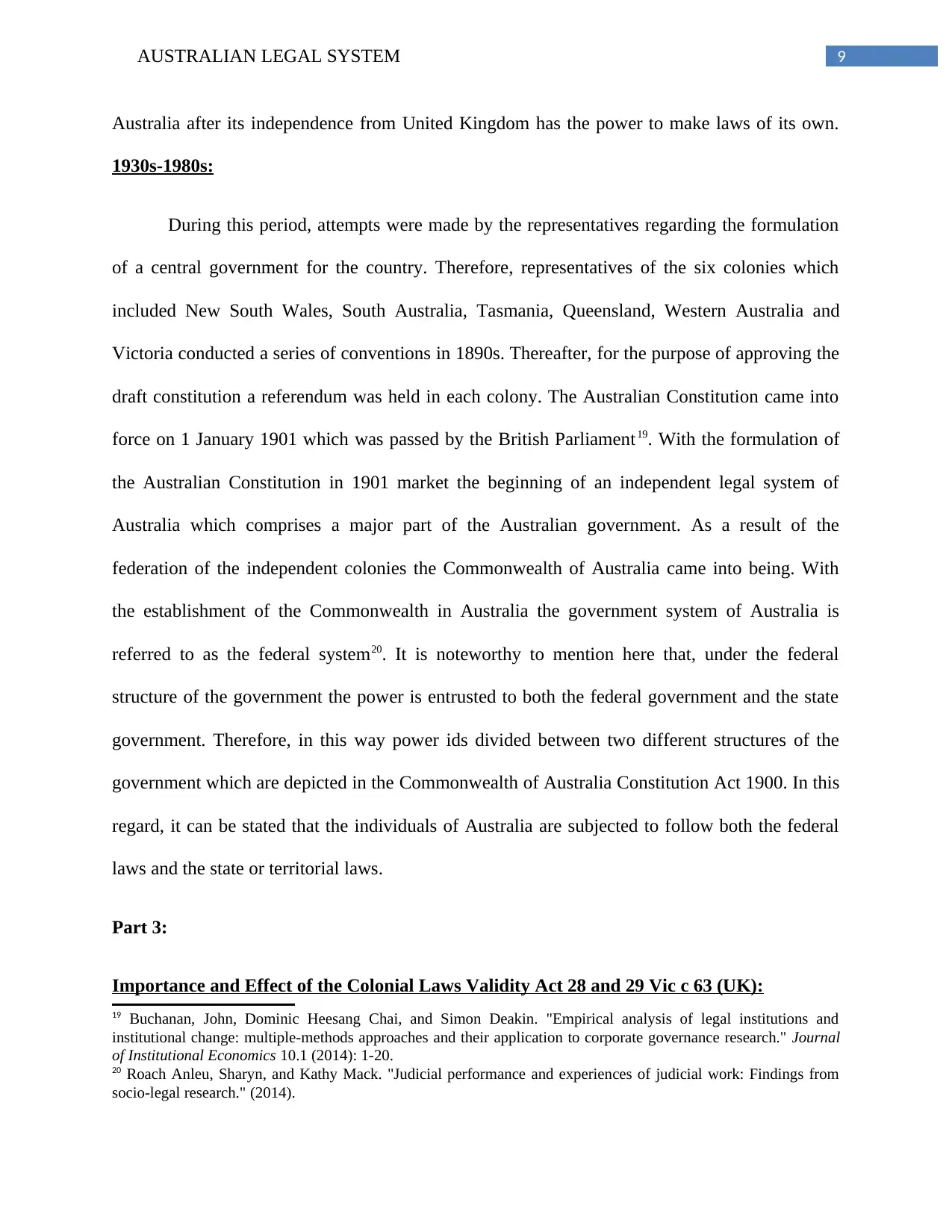
9AUSTRALIAN LEGAL SYSTEM
Australia after its independence from United Kingdom has the power to make laws of its own.
1930s-1980s:
During this period, attempts were made by the representatives regarding the formulation
of a central government for the country. Therefore, representatives of the six colonies which
included New South Wales, South Australia, Tasmania, Queensland, Western Australia and
Victoria conducted a series of conventions in 1890s. Thereafter, for the purpose of approving the
draft constitution a referendum was held in each colony. The Australian Constitution came into
force on 1 January 1901 which was passed by the British Parliament19. With the formulation of
the Australian Constitution in 1901 market the beginning of an independent legal system of
Australia which comprises a major part of the Australian government. As a result of the
federation of the independent colonies the Commonwealth of Australia came into being. With
the establishment of the Commonwealth in Australia the government system of Australia is
referred to as the federal system20. It is noteworthy to mention here that, under the federal
structure of the government the power is entrusted to both the federal government and the state
government. Therefore, in this way power ids divided between two different structures of the
government which are depicted in the Commonwealth of Australia Constitution Act 1900. In this
regard, it can be stated that the individuals of Australia are subjected to follow both the federal
laws and the state or territorial laws.
Part 3:
Importance and Effect of the Colonial Laws Validity Act 28 and 29 Vic c 63 (UK):
19 Buchanan, John, Dominic Heesang Chai, and Simon Deakin. "Empirical analysis of legal institutions and
institutional change: multiple-methods approaches and their application to corporate governance research." Journal
of Institutional Economics 10.1 (2014): 1-20.
20 Roach Anleu, Sharyn, and Kathy Mack. "Judicial performance and experiences of judicial work: Findings from
socio-legal research." (2014).
Australia after its independence from United Kingdom has the power to make laws of its own.
1930s-1980s:
During this period, attempts were made by the representatives regarding the formulation
of a central government for the country. Therefore, representatives of the six colonies which
included New South Wales, South Australia, Tasmania, Queensland, Western Australia and
Victoria conducted a series of conventions in 1890s. Thereafter, for the purpose of approving the
draft constitution a referendum was held in each colony. The Australian Constitution came into
force on 1 January 1901 which was passed by the British Parliament19. With the formulation of
the Australian Constitution in 1901 market the beginning of an independent legal system of
Australia which comprises a major part of the Australian government. As a result of the
federation of the independent colonies the Commonwealth of Australia came into being. With
the establishment of the Commonwealth in Australia the government system of Australia is
referred to as the federal system20. It is noteworthy to mention here that, under the federal
structure of the government the power is entrusted to both the federal government and the state
government. Therefore, in this way power ids divided between two different structures of the
government which are depicted in the Commonwealth of Australia Constitution Act 1900. In this
regard, it can be stated that the individuals of Australia are subjected to follow both the federal
laws and the state or territorial laws.
Part 3:
Importance and Effect of the Colonial Laws Validity Act 28 and 29 Vic c 63 (UK):
19 Buchanan, John, Dominic Heesang Chai, and Simon Deakin. "Empirical analysis of legal institutions and
institutional change: multiple-methods approaches and their application to corporate governance research." Journal
of Institutional Economics 10.1 (2014): 1-20.
20 Roach Anleu, Sharyn, and Kathy Mack. "Judicial performance and experiences of judicial work: Findings from
socio-legal research." (2014).
Secure Best Marks with AI Grader
Need help grading? Try our AI Grader for instant feedback on your assignments.
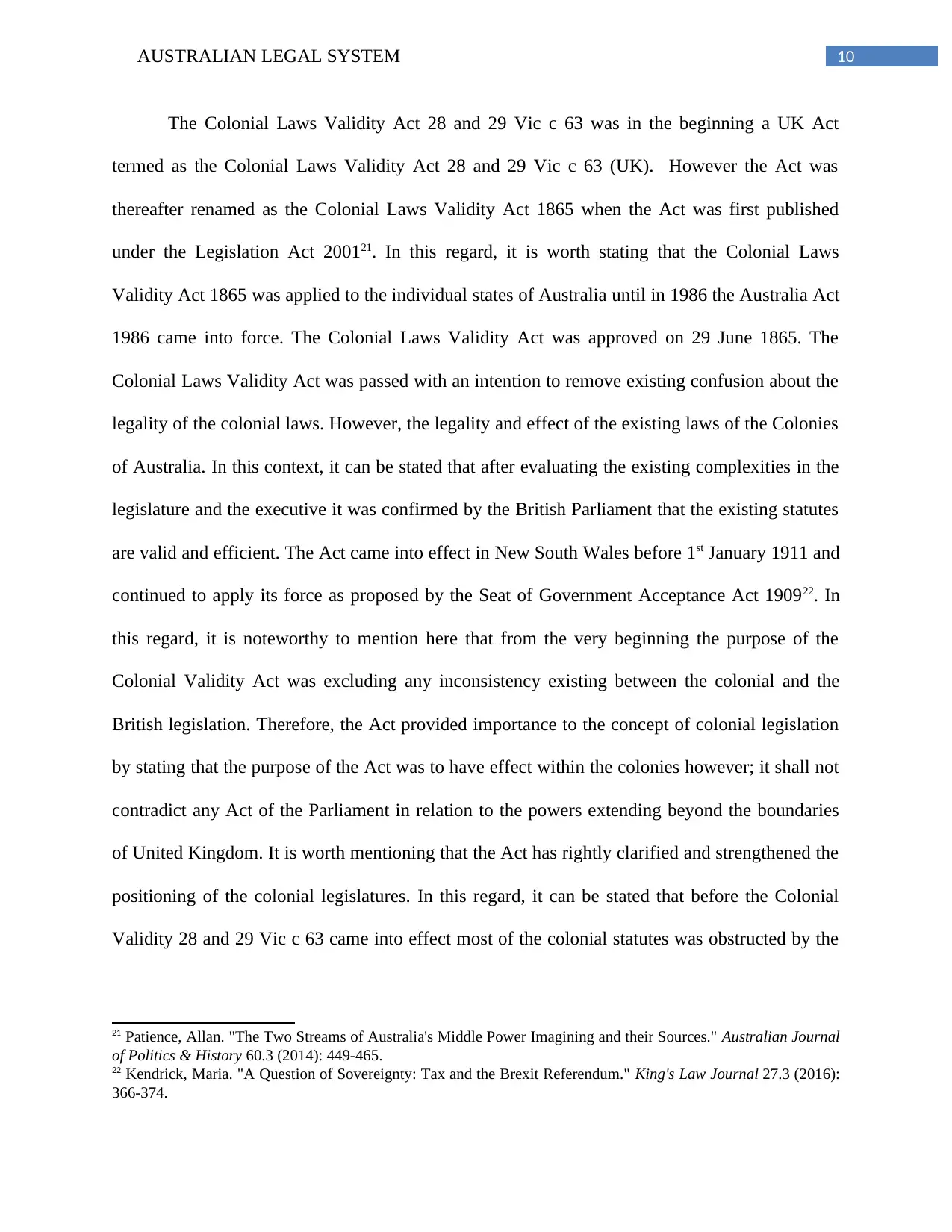
10AUSTRALIAN LEGAL SYSTEM
The Colonial Laws Validity Act 28 and 29 Vic c 63 was in the beginning a UK Act
termed as the Colonial Laws Validity Act 28 and 29 Vic c 63 (UK). However the Act was
thereafter renamed as the Colonial Laws Validity Act 1865 when the Act was first published
under the Legislation Act 200121. In this regard, it is worth stating that the Colonial Laws
Validity Act 1865 was applied to the individual states of Australia until in 1986 the Australia Act
1986 came into force. The Colonial Laws Validity Act was approved on 29 June 1865. The
Colonial Laws Validity Act was passed with an intention to remove existing confusion about the
legality of the colonial laws. However, the legality and effect of the existing laws of the Colonies
of Australia. In this context, it can be stated that after evaluating the existing complexities in the
legislature and the executive it was confirmed by the British Parliament that the existing statutes
are valid and efficient. The Act came into effect in New South Wales before 1st January 1911 and
continued to apply its force as proposed by the Seat of Government Acceptance Act 190922. In
this regard, it is noteworthy to mention here that from the very beginning the purpose of the
Colonial Validity Act was excluding any inconsistency existing between the colonial and the
British legislation. Therefore, the Act provided importance to the concept of colonial legislation
by stating that the purpose of the Act was to have effect within the colonies however; it shall not
contradict any Act of the Parliament in relation to the powers extending beyond the boundaries
of United Kingdom. It is worth mentioning that the Act has rightly clarified and strengthened the
positioning of the colonial legislatures. In this regard, it can be stated that before the Colonial
Validity 28 and 29 Vic c 63 came into effect most of the colonial statutes was obstructed by the
21 Patience, Allan. "The Two Streams of Australia's Middle Power Imagining and their Sources." Australian Journal
of Politics & History 60.3 (2014): 449-465.
22 Kendrick, Maria. "A Question of Sovereignty: Tax and the Brexit Referendum." King's Law Journal 27.3 (2016):
366-374.
The Colonial Laws Validity Act 28 and 29 Vic c 63 was in the beginning a UK Act
termed as the Colonial Laws Validity Act 28 and 29 Vic c 63 (UK). However the Act was
thereafter renamed as the Colonial Laws Validity Act 1865 when the Act was first published
under the Legislation Act 200121. In this regard, it is worth stating that the Colonial Laws
Validity Act 1865 was applied to the individual states of Australia until in 1986 the Australia Act
1986 came into force. The Colonial Laws Validity Act was approved on 29 June 1865. The
Colonial Laws Validity Act was passed with an intention to remove existing confusion about the
legality of the colonial laws. However, the legality and effect of the existing laws of the Colonies
of Australia. In this context, it can be stated that after evaluating the existing complexities in the
legislature and the executive it was confirmed by the British Parliament that the existing statutes
are valid and efficient. The Act came into effect in New South Wales before 1st January 1911 and
continued to apply its force as proposed by the Seat of Government Acceptance Act 190922. In
this regard, it is noteworthy to mention here that from the very beginning the purpose of the
Colonial Validity Act was excluding any inconsistency existing between the colonial and the
British legislation. Therefore, the Act provided importance to the concept of colonial legislation
by stating that the purpose of the Act was to have effect within the colonies however; it shall not
contradict any Act of the Parliament in relation to the powers extending beyond the boundaries
of United Kingdom. It is worth mentioning that the Act has rightly clarified and strengthened the
positioning of the colonial legislatures. In this regard, it can be stated that before the Colonial
Validity 28 and 29 Vic c 63 came into effect most of the colonial statutes was obstructed by the
21 Patience, Allan. "The Two Streams of Australia's Middle Power Imagining and their Sources." Australian Journal
of Politics & History 60.3 (2014): 449-465.
22 Kendrick, Maria. "A Question of Sovereignty: Tax and the Brexit Referendum." King's Law Journal 27.3 (2016):
366-374.
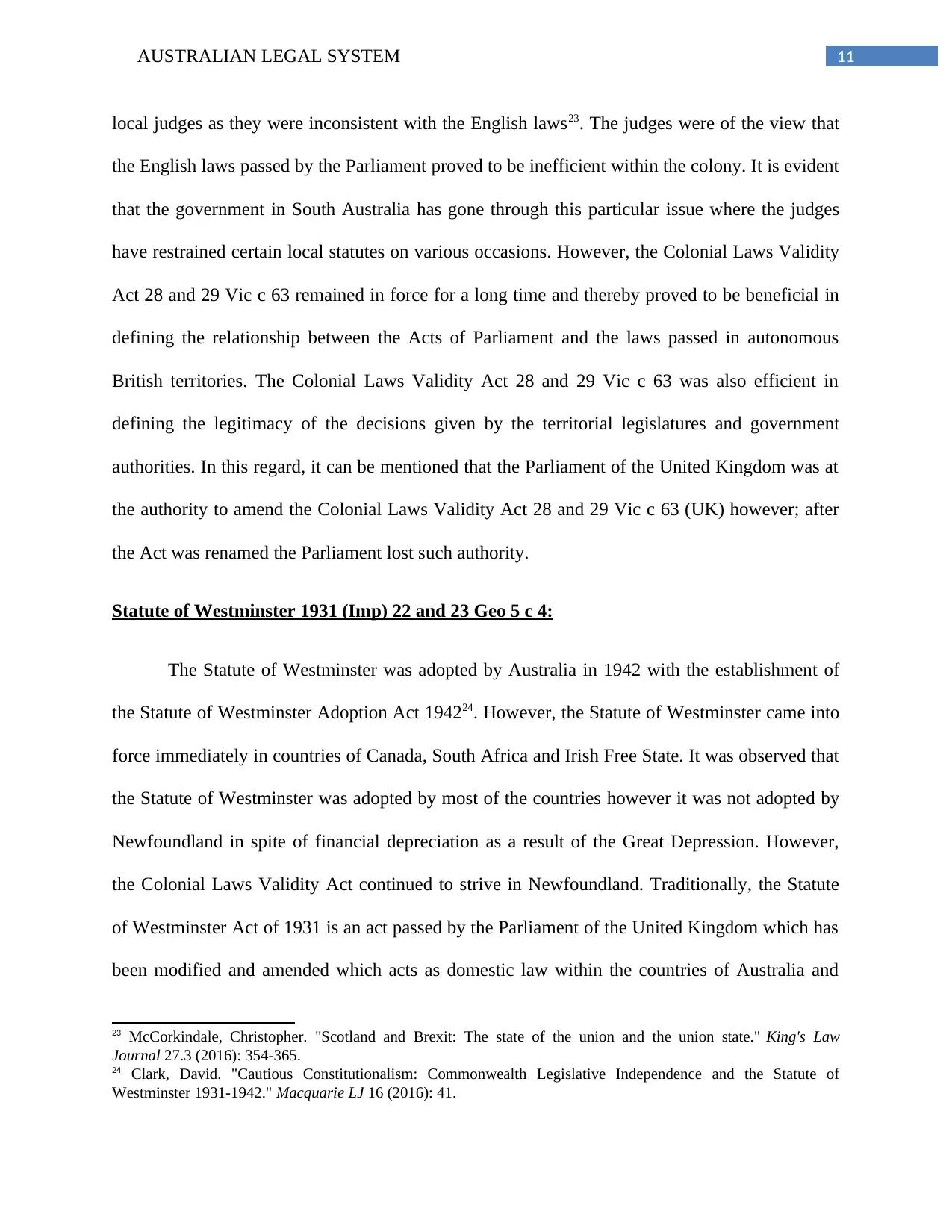
11AUSTRALIAN LEGAL SYSTEM
local judges as they were inconsistent with the English laws23. The judges were of the view that
the English laws passed by the Parliament proved to be inefficient within the colony. It is evident
that the government in South Australia has gone through this particular issue where the judges
have restrained certain local statutes on various occasions. However, the Colonial Laws Validity
Act 28 and 29 Vic c 63 remained in force for a long time and thereby proved to be beneficial in
defining the relationship between the Acts of Parliament and the laws passed in autonomous
British territories. The Colonial Laws Validity Act 28 and 29 Vic c 63 was also efficient in
defining the legitimacy of the decisions given by the territorial legislatures and government
authorities. In this regard, it can be mentioned that the Parliament of the United Kingdom was at
the authority to amend the Colonial Laws Validity Act 28 and 29 Vic c 63 (UK) however; after
the Act was renamed the Parliament lost such authority.
Statute of Westminster 1931 (Imp) 22 and 23 Geo 5 c 4:
The Statute of Westminster was adopted by Australia in 1942 with the establishment of
the Statute of Westminster Adoption Act 194224. However, the Statute of Westminster came into
force immediately in countries of Canada, South Africa and Irish Free State. It was observed that
the Statute of Westminster was adopted by most of the countries however it was not adopted by
Newfoundland in spite of financial depreciation as a result of the Great Depression. However,
the Colonial Laws Validity Act continued to strive in Newfoundland. Traditionally, the Statute
of Westminster Act of 1931 is an act passed by the Parliament of the United Kingdom which has
been modified and amended which acts as domestic law within the countries of Australia and
23 McCorkindale, Christopher. "Scotland and Brexit: The state of the union and the union state." King's Law
Journal 27.3 (2016): 354-365.
24 Clark, David. "Cautious Constitutionalism: Commonwealth Legislative Independence and the Statute of
Westminster 1931-1942." Macquarie LJ 16 (2016): 41.
local judges as they were inconsistent with the English laws23. The judges were of the view that
the English laws passed by the Parliament proved to be inefficient within the colony. It is evident
that the government in South Australia has gone through this particular issue where the judges
have restrained certain local statutes on various occasions. However, the Colonial Laws Validity
Act 28 and 29 Vic c 63 remained in force for a long time and thereby proved to be beneficial in
defining the relationship between the Acts of Parliament and the laws passed in autonomous
British territories. The Colonial Laws Validity Act 28 and 29 Vic c 63 was also efficient in
defining the legitimacy of the decisions given by the territorial legislatures and government
authorities. In this regard, it can be mentioned that the Parliament of the United Kingdom was at
the authority to amend the Colonial Laws Validity Act 28 and 29 Vic c 63 (UK) however; after
the Act was renamed the Parliament lost such authority.
Statute of Westminster 1931 (Imp) 22 and 23 Geo 5 c 4:
The Statute of Westminster was adopted by Australia in 1942 with the establishment of
the Statute of Westminster Adoption Act 194224. However, the Statute of Westminster came into
force immediately in countries of Canada, South Africa and Irish Free State. It was observed that
the Statute of Westminster was adopted by most of the countries however it was not adopted by
Newfoundland in spite of financial depreciation as a result of the Great Depression. However,
the Colonial Laws Validity Act continued to strive in Newfoundland. Traditionally, the Statute
of Westminster Act of 1931 is an act passed by the Parliament of the United Kingdom which has
been modified and amended which acts as domestic law within the countries of Australia and
23 McCorkindale, Christopher. "Scotland and Brexit: The state of the union and the union state." King's Law
Journal 27.3 (2016): 354-365.
24 Clark, David. "Cautious Constitutionalism: Commonwealth Legislative Independence and the Statute of
Westminster 1931-1942." Macquarie LJ 16 (2016): 41.
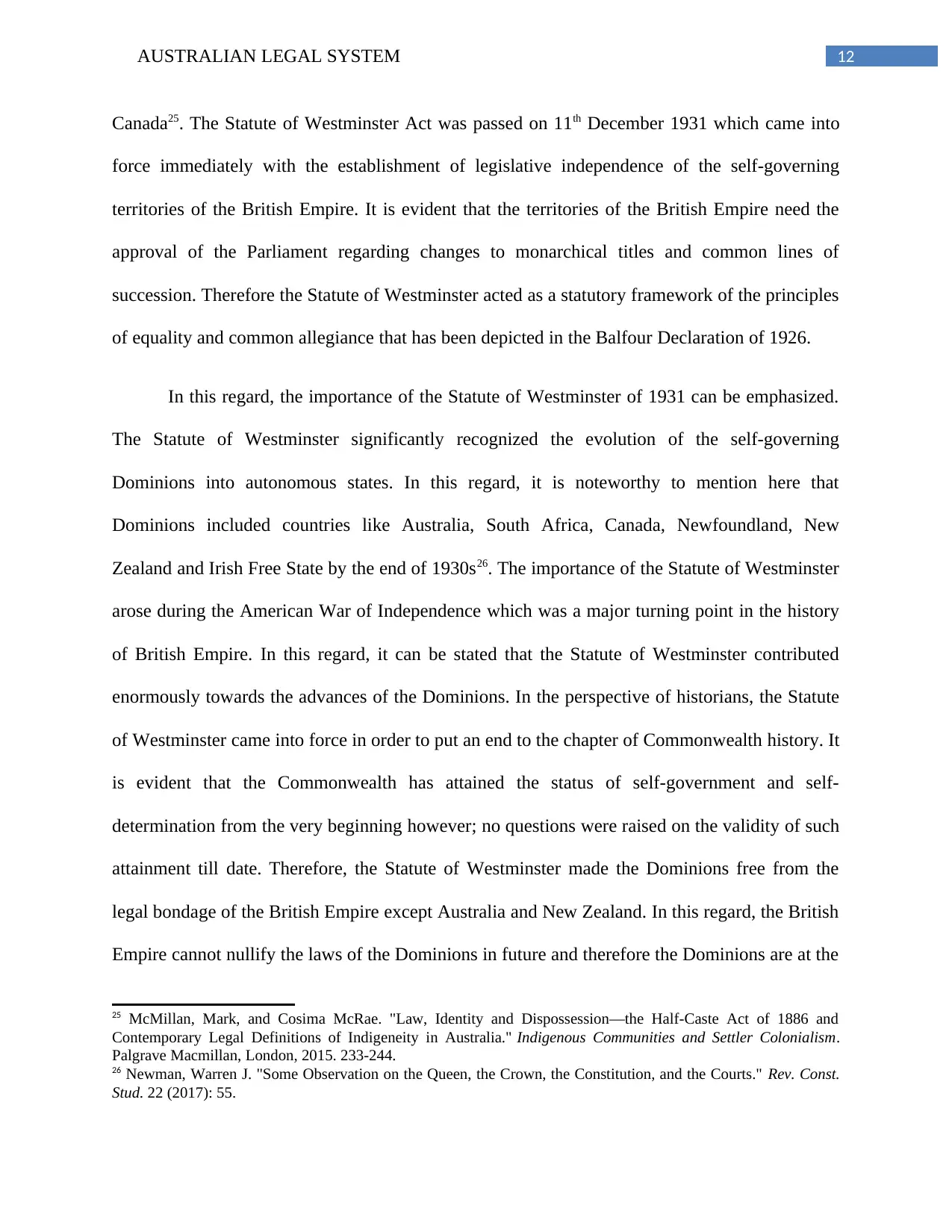
12AUSTRALIAN LEGAL SYSTEM
Canada25. The Statute of Westminster Act was passed on 11th December 1931 which came into
force immediately with the establishment of legislative independence of the self-governing
territories of the British Empire. It is evident that the territories of the British Empire need the
approval of the Parliament regarding changes to monarchical titles and common lines of
succession. Therefore the Statute of Westminster acted as a statutory framework of the principles
of equality and common allegiance that has been depicted in the Balfour Declaration of 1926.
In this regard, the importance of the Statute of Westminster of 1931 can be emphasized.
The Statute of Westminster significantly recognized the evolution of the self-governing
Dominions into autonomous states. In this regard, it is noteworthy to mention here that
Dominions included countries like Australia, South Africa, Canada, Newfoundland, New
Zealand and Irish Free State by the end of 1930s26. The importance of the Statute of Westminster
arose during the American War of Independence which was a major turning point in the history
of British Empire. In this regard, it can be stated that the Statute of Westminster contributed
enormously towards the advances of the Dominions. In the perspective of historians, the Statute
of Westminster came into force in order to put an end to the chapter of Commonwealth history. It
is evident that the Commonwealth has attained the status of self-government and self-
determination from the very beginning however; no questions were raised on the validity of such
attainment till date. Therefore, the Statute of Westminster made the Dominions free from the
legal bondage of the British Empire except Australia and New Zealand. In this regard, the British
Empire cannot nullify the laws of the Dominions in future and therefore the Dominions are at the
25 McMillan, Mark, and Cosima McRae. "Law, Identity and Dispossession—the Half-Caste Act of 1886 and
Contemporary Legal Definitions of Indigeneity in Australia." Indigenous Communities and Settler Colonialism.
Palgrave Macmillan, London, 2015. 233-244.
26 Newman, Warren J. "Some Observation on the Queen, the Crown, the Constitution, and the Courts." Rev. Const.
Stud. 22 (2017): 55.
Canada25. The Statute of Westminster Act was passed on 11th December 1931 which came into
force immediately with the establishment of legislative independence of the self-governing
territories of the British Empire. It is evident that the territories of the British Empire need the
approval of the Parliament regarding changes to monarchical titles and common lines of
succession. Therefore the Statute of Westminster acted as a statutory framework of the principles
of equality and common allegiance that has been depicted in the Balfour Declaration of 1926.
In this regard, the importance of the Statute of Westminster of 1931 can be emphasized.
The Statute of Westminster significantly recognized the evolution of the self-governing
Dominions into autonomous states. In this regard, it is noteworthy to mention here that
Dominions included countries like Australia, South Africa, Canada, Newfoundland, New
Zealand and Irish Free State by the end of 1930s26. The importance of the Statute of Westminster
arose during the American War of Independence which was a major turning point in the history
of British Empire. In this regard, it can be stated that the Statute of Westminster contributed
enormously towards the advances of the Dominions. In the perspective of historians, the Statute
of Westminster came into force in order to put an end to the chapter of Commonwealth history. It
is evident that the Commonwealth has attained the status of self-government and self-
determination from the very beginning however; no questions were raised on the validity of such
attainment till date. Therefore, the Statute of Westminster made the Dominions free from the
legal bondage of the British Empire except Australia and New Zealand. In this regard, the British
Empire cannot nullify the laws of the Dominions in future and therefore the Dominions are at the
25 McMillan, Mark, and Cosima McRae. "Law, Identity and Dispossession—the Half-Caste Act of 1886 and
Contemporary Legal Definitions of Indigeneity in Australia." Indigenous Communities and Settler Colonialism.
Palgrave Macmillan, London, 2015. 233-244.
26 Newman, Warren J. "Some Observation on the Queen, the Crown, the Constitution, and the Courts." Rev. Const.
Stud. 22 (2017): 55.
Paraphrase This Document
Need a fresh take? Get an instant paraphrase of this document with our AI Paraphraser
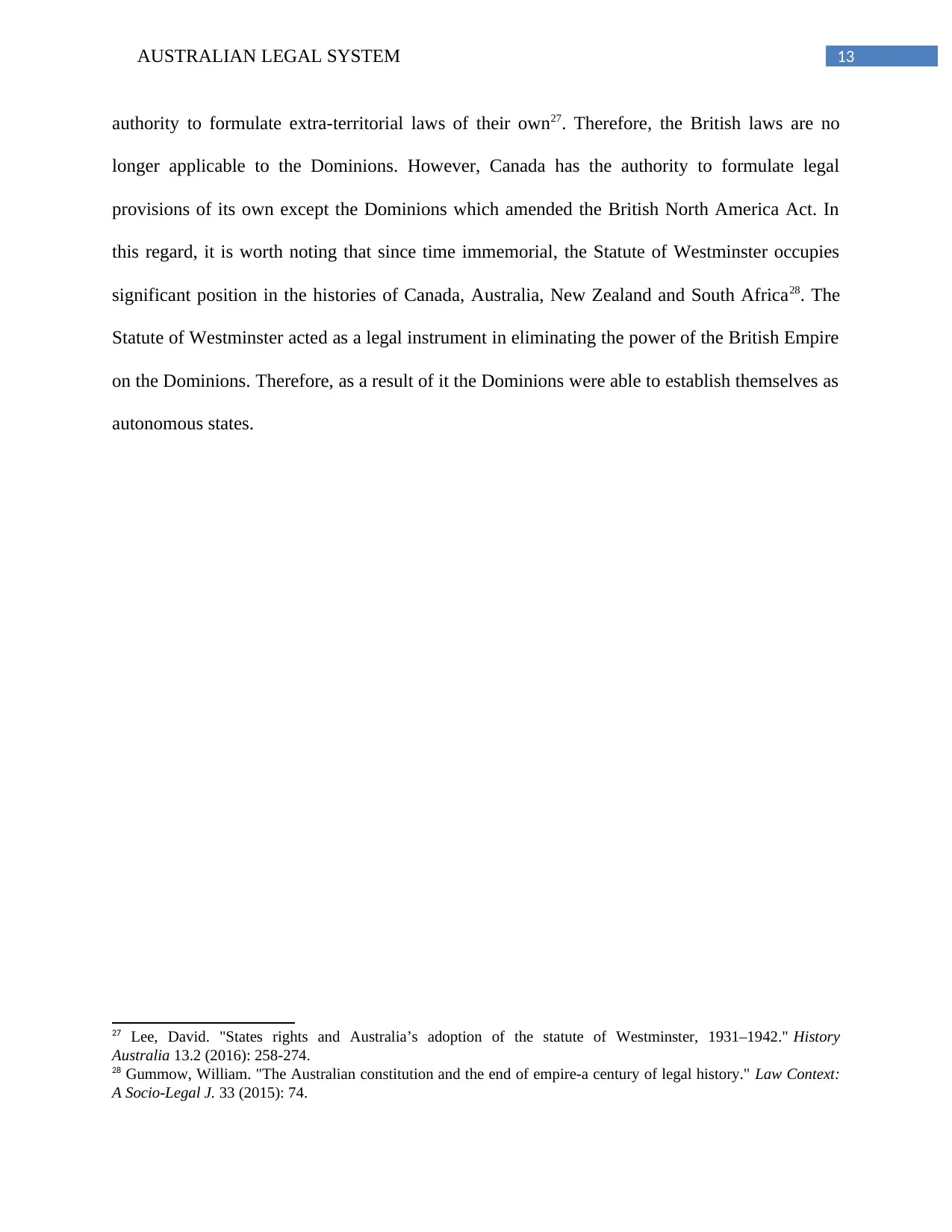
13AUSTRALIAN LEGAL SYSTEM
authority to formulate extra-territorial laws of their own27. Therefore, the British laws are no
longer applicable to the Dominions. However, Canada has the authority to formulate legal
provisions of its own except the Dominions which amended the British North America Act. In
this regard, it is worth noting that since time immemorial, the Statute of Westminster occupies
significant position in the histories of Canada, Australia, New Zealand and South Africa28. The
Statute of Westminster acted as a legal instrument in eliminating the power of the British Empire
on the Dominions. Therefore, as a result of it the Dominions were able to establish themselves as
autonomous states.
27 Lee, David. "States rights and Australia’s adoption of the statute of Westminster, 1931–1942." History
Australia 13.2 (2016): 258-274.
28 Gummow, William. "The Australian constitution and the end of empire-a century of legal history." Law Context:
A Socio-Legal J. 33 (2015): 74.
authority to formulate extra-territorial laws of their own27. Therefore, the British laws are no
longer applicable to the Dominions. However, Canada has the authority to formulate legal
provisions of its own except the Dominions which amended the British North America Act. In
this regard, it is worth noting that since time immemorial, the Statute of Westminster occupies
significant position in the histories of Canada, Australia, New Zealand and South Africa28. The
Statute of Westminster acted as a legal instrument in eliminating the power of the British Empire
on the Dominions. Therefore, as a result of it the Dominions were able to establish themselves as
autonomous states.
27 Lee, David. "States rights and Australia’s adoption of the statute of Westminster, 1931–1942." History
Australia 13.2 (2016): 258-274.
28 Gummow, William. "The Australian constitution and the end of empire-a century of legal history." Law Context:
A Socio-Legal J. 33 (2015): 74.
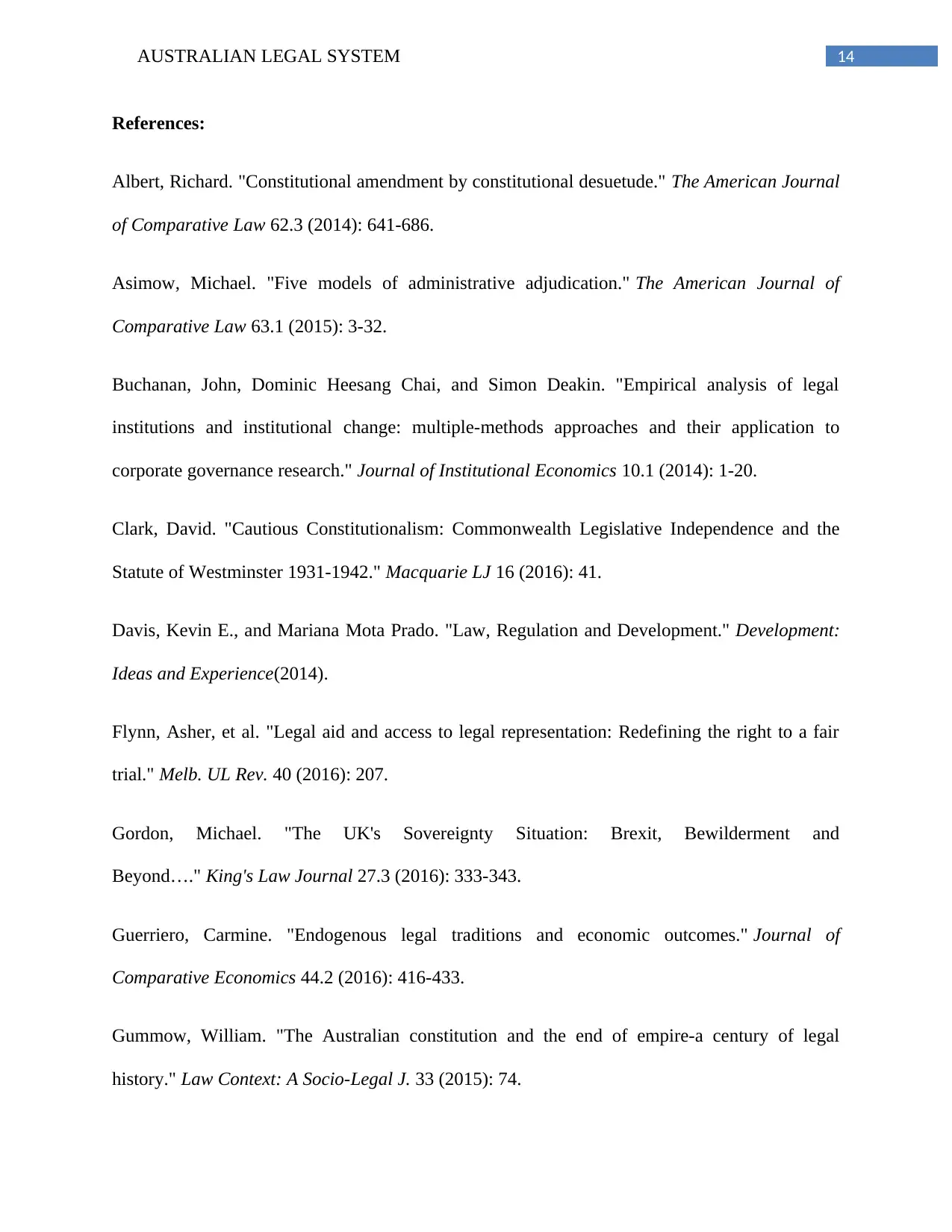
14AUSTRALIAN LEGAL SYSTEM
References:
Albert, Richard. "Constitutional amendment by constitutional desuetude." The American Journal
of Comparative Law 62.3 (2014): 641-686.
Asimow, Michael. "Five models of administrative adjudication." The American Journal of
Comparative Law 63.1 (2015): 3-32.
Buchanan, John, Dominic Heesang Chai, and Simon Deakin. "Empirical analysis of legal
institutions and institutional change: multiple-methods approaches and their application to
corporate governance research." Journal of Institutional Economics 10.1 (2014): 1-20.
Clark, David. "Cautious Constitutionalism: Commonwealth Legislative Independence and the
Statute of Westminster 1931-1942." Macquarie LJ 16 (2016): 41.
Davis, Kevin E., and Mariana Mota Prado. "Law, Regulation and Development." Development:
Ideas and Experience(2014).
Flynn, Asher, et al. "Legal aid and access to legal representation: Redefining the right to a fair
trial." Melb. UL Rev. 40 (2016): 207.
Gordon, Michael. "The UK's Sovereignty Situation: Brexit, Bewilderment and
Beyond…." King's Law Journal 27.3 (2016): 333-343.
Guerriero, Carmine. "Endogenous legal traditions and economic outcomes." Journal of
Comparative Economics 44.2 (2016): 416-433.
Gummow, William. "The Australian constitution and the end of empire-a century of legal
history." Law Context: A Socio-Legal J. 33 (2015): 74.
References:
Albert, Richard. "Constitutional amendment by constitutional desuetude." The American Journal
of Comparative Law 62.3 (2014): 641-686.
Asimow, Michael. "Five models of administrative adjudication." The American Journal of
Comparative Law 63.1 (2015): 3-32.
Buchanan, John, Dominic Heesang Chai, and Simon Deakin. "Empirical analysis of legal
institutions and institutional change: multiple-methods approaches and their application to
corporate governance research." Journal of Institutional Economics 10.1 (2014): 1-20.
Clark, David. "Cautious Constitutionalism: Commonwealth Legislative Independence and the
Statute of Westminster 1931-1942." Macquarie LJ 16 (2016): 41.
Davis, Kevin E., and Mariana Mota Prado. "Law, Regulation and Development." Development:
Ideas and Experience(2014).
Flynn, Asher, et al. "Legal aid and access to legal representation: Redefining the right to a fair
trial." Melb. UL Rev. 40 (2016): 207.
Gordon, Michael. "The UK's Sovereignty Situation: Brexit, Bewilderment and
Beyond…." King's Law Journal 27.3 (2016): 333-343.
Guerriero, Carmine. "Endogenous legal traditions and economic outcomes." Journal of
Comparative Economics 44.2 (2016): 416-433.
Gummow, William. "The Australian constitution and the end of empire-a century of legal
history." Law Context: A Socio-Legal J. 33 (2015): 74.

15AUSTRALIAN LEGAL SYSTEM
Hayo, Bernd, and Stefan Voigt. "Mapping Constitutionally Safeguarded Judicial Independence
—A Global Survey." Journal of Empirical Legal Studies 11.1 (2014): 159-195.
Hillmer, Norman, and Philippe Lagassé. "Parliament will decide: An interplay of politics and
principle." International Journal 71.2 (2016): 328-337.
Kendrick, Maria. "A Question of Sovereignty: Tax and the Brexit Referendum." King's Law
Journal 27.3 (2016): 366-374.
Klabbers, Jan. "The emergence of functionalism in international institutional law: colonial
inspirations." European Journal of International Law 25.3 (2014): 645-675.
Lee, David. "States rights and Australia’s adoption of the statute of Westminster, 1931–
1942." History Australia 13.2 (2016): 258-274.
Marchetti, Elena, and Janet Ransley. "Applying the critical Lens to judicial Officers and Legal
Practitioners involved in sentencing Indigenous Offenders: Will anyone or anything
do." UNSWLJ 37 (2014): 1.
Marchetti, Elena, and Janet Ransley. "Applying the critical Lens to judicial Officers and Legal
Practitioners involved in sentencing Indigenous Offenders: Will anyone or anything
do." UNSWLJ 37 (2014): 1.
McCorkindale, Christopher. "Scotland and Brexit: The state of the union and the union
state." King's Law Journal 27.3 (2016): 354-365.
McMillan, Mark, and Cosima McRae. "Law, Identity and Dispossession—the Half-Caste Act of
1886 and Contemporary Legal Definitions of Indigeneity in Australia." Indigenous Communities
and Settler Colonialism. Palgrave Macmillan, London, 2015. 233-244.
Hayo, Bernd, and Stefan Voigt. "Mapping Constitutionally Safeguarded Judicial Independence
—A Global Survey." Journal of Empirical Legal Studies 11.1 (2014): 159-195.
Hillmer, Norman, and Philippe Lagassé. "Parliament will decide: An interplay of politics and
principle." International Journal 71.2 (2016): 328-337.
Kendrick, Maria. "A Question of Sovereignty: Tax and the Brexit Referendum." King's Law
Journal 27.3 (2016): 366-374.
Klabbers, Jan. "The emergence of functionalism in international institutional law: colonial
inspirations." European Journal of International Law 25.3 (2014): 645-675.
Lee, David. "States rights and Australia’s adoption of the statute of Westminster, 1931–
1942." History Australia 13.2 (2016): 258-274.
Marchetti, Elena, and Janet Ransley. "Applying the critical Lens to judicial Officers and Legal
Practitioners involved in sentencing Indigenous Offenders: Will anyone or anything
do." UNSWLJ 37 (2014): 1.
Marchetti, Elena, and Janet Ransley. "Applying the critical Lens to judicial Officers and Legal
Practitioners involved in sentencing Indigenous Offenders: Will anyone or anything
do." UNSWLJ 37 (2014): 1.
McCorkindale, Christopher. "Scotland and Brexit: The state of the union and the union
state." King's Law Journal 27.3 (2016): 354-365.
McMillan, Mark, and Cosima McRae. "Law, Identity and Dispossession—the Half-Caste Act of
1886 and Contemporary Legal Definitions of Indigeneity in Australia." Indigenous Communities
and Settler Colonialism. Palgrave Macmillan, London, 2015. 233-244.
Secure Best Marks with AI Grader
Need help grading? Try our AI Grader for instant feedback on your assignments.

16AUSTRALIAN LEGAL SYSTEM
Meagher, Dan. "The principle of legality as clear statement rule: significance and
problems." Sydney L. Rev. 36 (2014): 413.
Nepal, Rabindra, Flavio Menezes, and Tooraj Jamasb. "Network regulation and regulatory
institutional reform: Revisiting the case of Australia." Energy Policy 73 (2014): 259-268.
Newman, Warren J. "Some Observation on the Queen, the Crown, the Constitution, and the
Courts." Rev. Const. Stud. 22 (2017): 55.
Patience, Allan. "The Two Streams of Australia's Middle Power Imagining and their
Sources." Australian Journal of Politics & History 60.3 (2014): 449-465.
Preston, Brian J. "Characteristics of successful environmental courts and tribunals." Journal of
Environmental law 26.3 (2014): 365-393.
Roach Anleu, Sharyn, and Kathy Mack. "Judicial performance and experiences of judicial work:
Findings from socio-legal research." (2014).
Short, Damien. Reconciliation and colonial power: Indigenous rights in Australia. Routledge,
2016.
Thomson, Lorraine, Morag McArthur, and Peter Camilleri. "Is it ‘fair'? Representation of
children, young people and parents in an adversarial court system." Child & Family Social
Work22.S2 (2017): 23-32.
Wardle, Jonathan Jon, et al. "Regulatory and legislative protections for consumers in
complementary medicine: lessons from Australian policy and legal developments." European
Journal of Integrative Medicine 6.4 (2014): 423-433.
Meagher, Dan. "The principle of legality as clear statement rule: significance and
problems." Sydney L. Rev. 36 (2014): 413.
Nepal, Rabindra, Flavio Menezes, and Tooraj Jamasb. "Network regulation and regulatory
institutional reform: Revisiting the case of Australia." Energy Policy 73 (2014): 259-268.
Newman, Warren J. "Some Observation on the Queen, the Crown, the Constitution, and the
Courts." Rev. Const. Stud. 22 (2017): 55.
Patience, Allan. "The Two Streams of Australia's Middle Power Imagining and their
Sources." Australian Journal of Politics & History 60.3 (2014): 449-465.
Preston, Brian J. "Characteristics of successful environmental courts and tribunals." Journal of
Environmental law 26.3 (2014): 365-393.
Roach Anleu, Sharyn, and Kathy Mack. "Judicial performance and experiences of judicial work:
Findings from socio-legal research." (2014).
Short, Damien. Reconciliation and colonial power: Indigenous rights in Australia. Routledge,
2016.
Thomson, Lorraine, Morag McArthur, and Peter Camilleri. "Is it ‘fair'? Representation of
children, young people and parents in an adversarial court system." Child & Family Social
Work22.S2 (2017): 23-32.
Wardle, Jonathan Jon, et al. "Regulatory and legislative protections for consumers in
complementary medicine: lessons from Australian policy and legal developments." European
Journal of Integrative Medicine 6.4 (2014): 423-433.
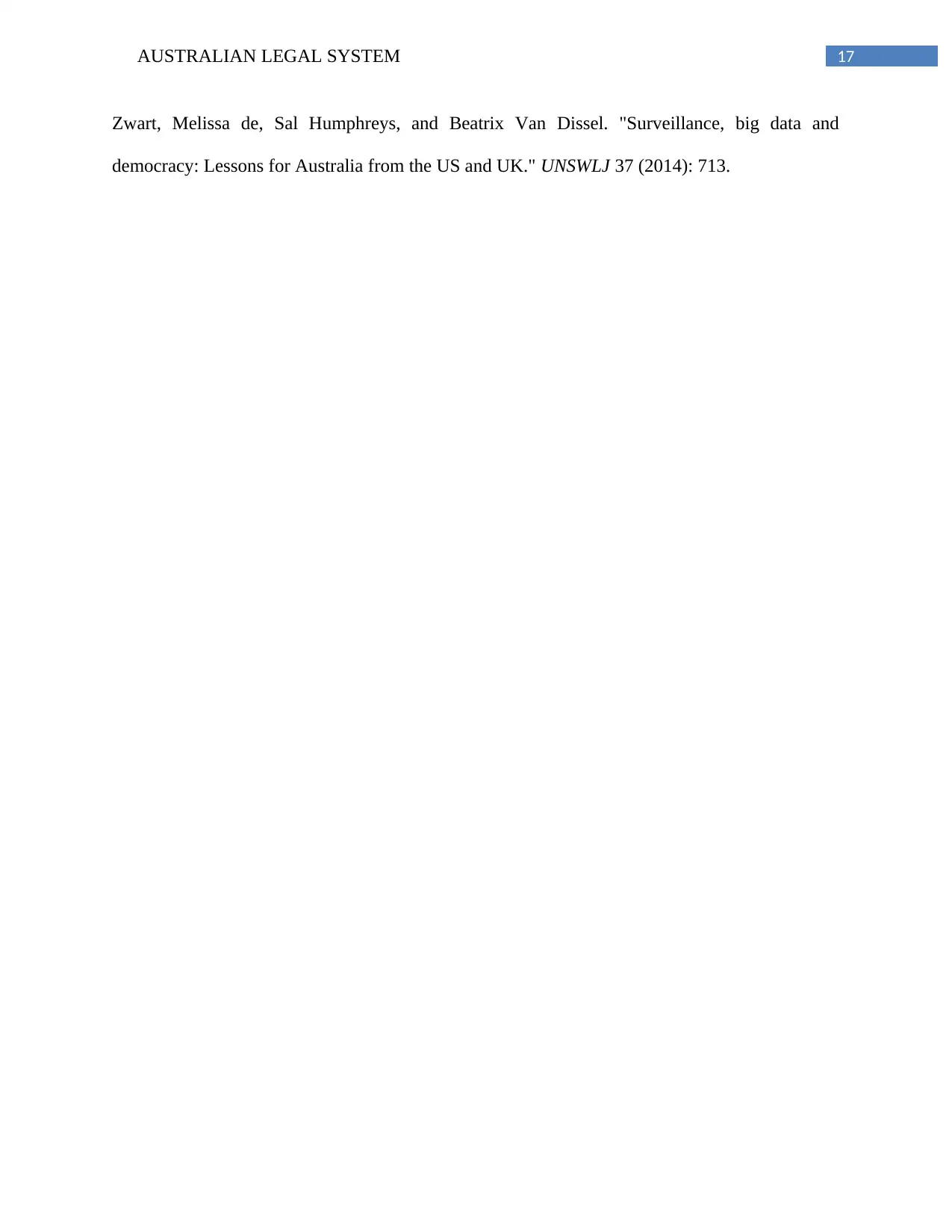
17AUSTRALIAN LEGAL SYSTEM
Zwart, Melissa de, Sal Humphreys, and Beatrix Van Dissel. "Surveillance, big data and
democracy: Lessons for Australia from the US and UK." UNSWLJ 37 (2014): 713.
Zwart, Melissa de, Sal Humphreys, and Beatrix Van Dissel. "Surveillance, big data and
democracy: Lessons for Australia from the US and UK." UNSWLJ 37 (2014): 713.
1 out of 18
Related Documents
Your All-in-One AI-Powered Toolkit for Academic Success.
+13062052269
info@desklib.com
Available 24*7 on WhatsApp / Email
![[object Object]](/_next/static/media/star-bottom.7253800d.svg)
Unlock your academic potential
© 2024 | Zucol Services PVT LTD | All rights reserved.





